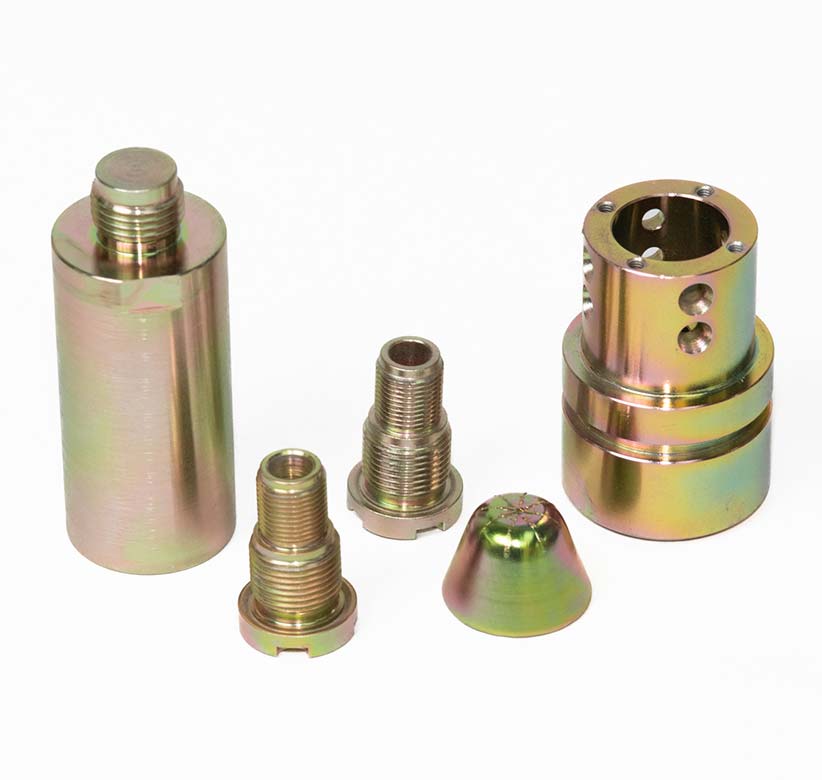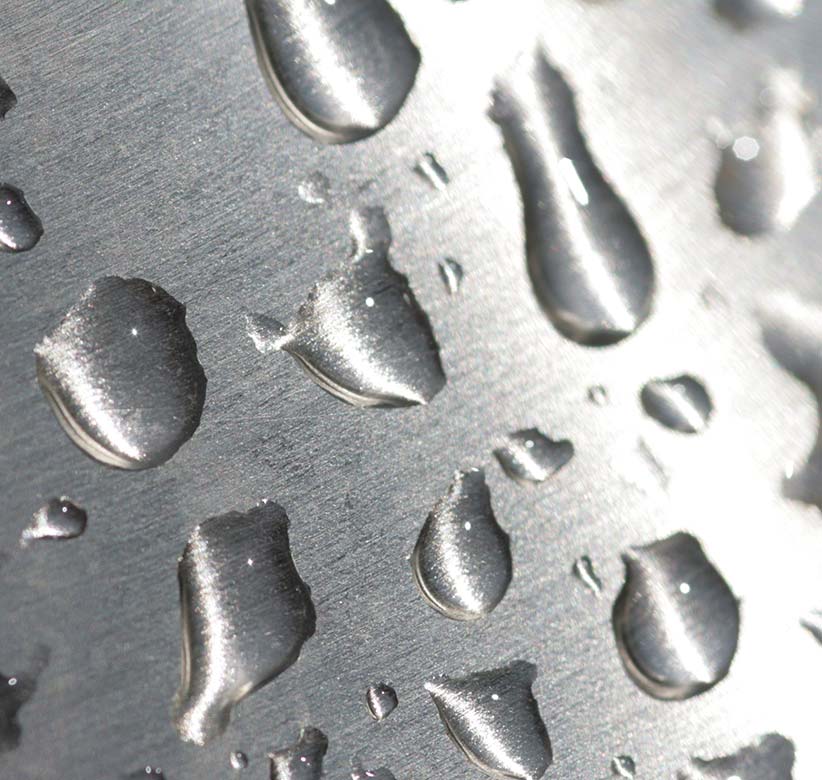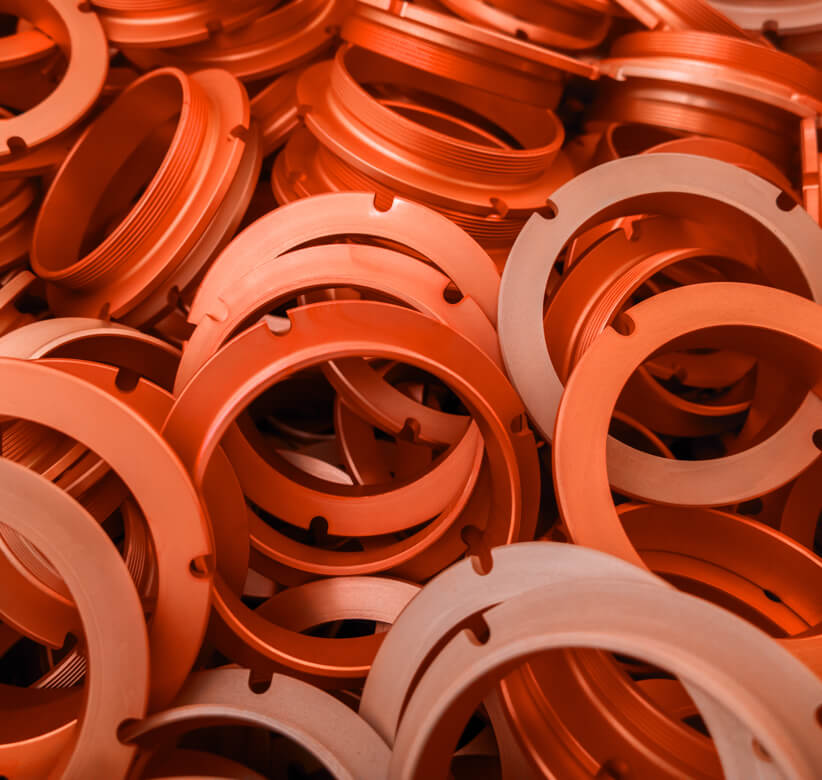Oxyver Service is specialized in galvanic treatments on aluminium and other metals, both for protective and decorative purposes.
The oxidation plant consists of semi-automatic tanks measuring 330 cm x 100 cm x 90 cm (length x width x depth) equipped with a radio-controlled overhead crane.
The electrolytic galvanizing line (white, yellow, black) is instead composed of tanks with maximum dimensions of 140 cm x 80 cm x 90 cm.

It is an electrolytic treatment on aluminium alloys that allows to obtain oxide layers of variable but controlled thickness.
It increases the surface hardness and resistance to friction and corrosion.
The chemical reaction is produced by the positioning at the anode of the pieces, where, due to the passage of current in a solution containing sulfuric acid, oxygen at the nascent state is generated, which forms high quality oxide.
The thicknesses vary from 5 to 20-25 microns and are defined according to the final characteristics to be obtained.
Before the final conditioning, the oxide layers, which are microporous, can be coloured by impregnation with different colours, immersing them in the tank.


The hard anodic oxidation is a modified version of the classic sulfuric oxidation. It is carried out by operating at a temperature of zero degrees using high current densities. All of our hard oxidation processes are carried out in order to give high resistance to corrosion with thicknesses that can also reach coatings in the range of 100-120 microns.
The other typical characteristics are:
Chromic passivation is a form of protection that allows aluminum to resist the aggression of the substances present in the atmosphere and, at the same time, it allows its high electrical conductivity to remain unaltered.
The resulting conversion layers are very thin (0.5 micron or less thick) and possess the property not only of providing adequate protection against corrosion but also of constituting a necessary support to ensure adhesion to the metal of subsequent organic finishing coats, such as varnishes or paints. The chromic passivation, while maintaining the conductivity of aluminum unaltered, is a treatment particularly suitable for products used in the electronic and military sectors.


The chemical nickel plating with medium phosphorus content (6-9%) and that with high phosphorus content between 10% – 12% is a storage with high corrosion, wear and anti-friction resistance. The coating takes place chemically without the use of electric current, thus allowing the treatment on any substrate and geometry. Since it is a chemical and non-electrolytic process, an extremely uniform coating thickness is obtained regardless of the geometry of the piece.
The electrolytic nickel plating is a conversion of the metallic nickel of the anode into nickel ions which, passing through a slightly acid solution of nickel salts (chloride and sulphate), are discharged onto the surface of the pieces where they convert back into metallic nickel.


Galvanizing is the process by which a zinc coating is applied to a metal product generally made of steel to protect it from galvanic corrosion: in fact, it limits the formation of electrolytic micro-cells with an anodic action in the grain edges. Depending on the requests, it is then passivated to give it the required colour.
Frame galvanizing alkaline process: particularly suitable for mechanical parts, where high deposit uniformity, high penetration and maximum corrosion protection are required.
Frame galvanizing acid process: for all the details where the aesthetic aspect is prevalent, with respect to uniformity of deposit and resistance to corrosion and for the treatment of difficult materials such as AVP and cast irons.
Galvanizing Barrel plating: in small barrels, capable of making medium-small batches and delicate pieces. Process suitable for all ferrous alloys.
The passivation of stainless steels allows to generate a thin protective film that ensures the particular a resistance to corrosion. Passivation, therefore, in addition to being a physical barrier against the passage of aggressive agents from the external environment to the metal substrate, also leads to an increase of the surface electrochemical potential of the metal, enhancing the stainless steel.


Hot burnishing
Hot burnishing consists in immersing the metal in water at a temperature greater than or equal to 100°C, adding substances such as copper sulphate and sodium hyposulfite. The object gradually changes its colour and once it reaches the desired colour it is extracted and left to cool at room temperature.
The burnishing gives metals a refined and elegant appearance, does not affect the shape and size of metal objects but initiates a chemical process that increases their surface friction. Thanks to the final oiling it also acts as an anti-rust and anti-corrosion treatment.
The coppering electrolytic galvanic treatment is a process of coating of a metal, through which it is coated with a layer of copper of various thickness according to the requests and needs of the customer. The treatment of electrolytic coppering is carried out in galvanic baths, where the copper metal becomes the anode and the metal material to be coated becomes the cathode.


The electronic tinning treatment is of great utility especially in the electronic and electromechanical sector due to its high conductivity and easy weldability qualities, but it is also the only one to be FDA approved for food substances.
Its base colour is milky white but its appearance can vary from opaque to glossy depending on the saline base of the deposition electrolyte.
Copyright© 2022 Oxyver Service s.r.l. VAT: 02463020590 | Privacy Policy